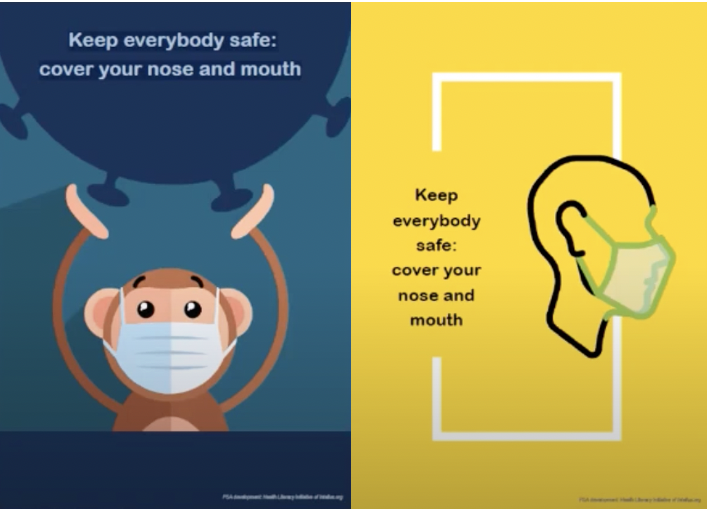Much of the preliminary COVID-19 information and guidelines were confusing to understand.
Health experts recommend medical information be written at an eighth-grade reading level, yet studies showed that most COVID-19 information was at an eleventh-grade reading level.
It’s critical to ensure life-saving health information is easily understood. This prompted the founding of a volunteer-led initiative and collaboration across several companies – including G3 Translate – called the Intellus Worldwide’s Health Literacy Initiative (HLI).
During a time when many were hand-sewing masks to donate during a national shortage, the HLI decided to study the effect of health literacy on mask safety. Here’s a summary of their findings.
Part One: Research and Design
The task for the HLI volunteers was clear: create a simple poster based on health literacy principles of clear communication to educate people on mask safety, then test its efficacy in the real world. However, determining how to make a poster both clear and informative, as well as able to influence behavior, took some research.
HLI members first reviewed and analyzed existing COVID-19 education resources from the Centers for Disease Control (CDC) and other official institutions. They found that they were often too complicated for layman’s terms.
They also interviewed essential workers on the front lines to determine the issues they see with people and their masks. One grocery store cashier commented, “People can’t seem to resist pulling their mask off to talk with me at my register.” This indicated that effective signage about mask requirements was definitely needed.
Another frontline worker in the healthcare field stated, “I write ‘tell me if my nose shows!’ on the outside of my mask, because that’s a gentle reminder to my patients to check their noses too.”
Thus, the idea for improved health communication began to take shape.
They needed to convey why wearing a mask is important and what people should do with their masks rather than what they shouldn’t by using positive, simple language.
Part Two: Consumer Survey
The next step for the HLI team was to test potential posters they created with consumers to determine the best option. To do this, they spoke to 16 men and 24 women between the ages of 18 and 65 and evaluated their reactions to both the text and the imagery.
The goal of the posters was to show people how to correctly and effectively wear their masks. Originally, the posters showed this with two masked faces—one incorrect and spreading pathogens via the nose, and one correct and fully protected.
However, these posters proved confusing to the consumers surveyed. They felt the message wasn’t immediately clear.
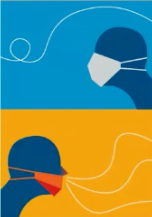
The HLI also considered using a stuffed animal on the poster instead of a person to make the message more friendly and inviting.
However, this also proved unclear, since the stuffed animal was reminiscent of an infant—an age group that should never be masked due to risk of suffocation.
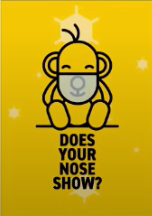
The image that tested the most highly among consumers polled was a toy monkey “holding the coronavirus” and wearing a mask over its nose and mouth. The toy monkey was appealing, the poster was clearly related to COVID-19, and the message was unambiguous.
The second highest-rated image was a simple masked face on a bright yellow background. The text popped nicely, and the consumers surveyed felt it was a secure, easy-to-understand choice.
Three different text options were presented to the consumers polled:
- “Keep everybody safe”
- “Cover your nose and mouth”
- “Be safe”
The first two were rated much higher than the last. This prompted the HLI to create a combined version to be clear and motivate readers to act: “Keep everybody safe: cover your nose and mouth.”
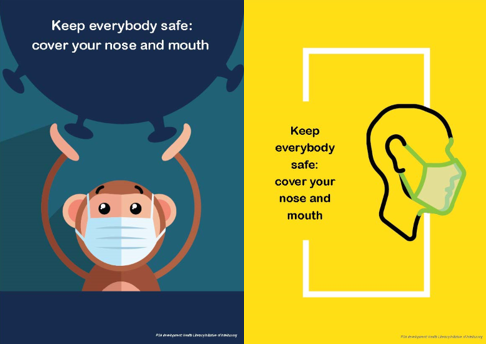
Part Three: Translation and Publication
Once they settled on final poster designs, the G3 Translate team localized and adapted the messaging into 27 different languages—ranging from Macedonian and Hindi to Swahili and Greek. These translated posters were then posted online for free public use for two critical reasons:
- Language barriers can be some of the largest obstacles in health literacy;
- The importance of ensuring COVID-19 safety information is widely accessible cannot be understated.
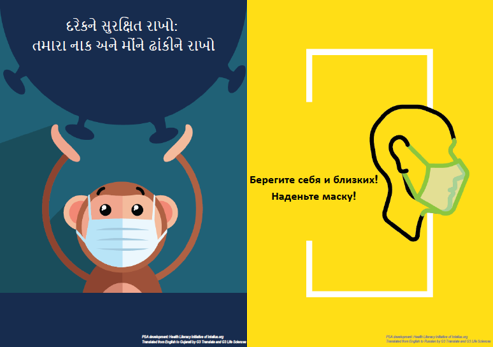
Part Four: Behavioral Study
Over the course of two months (February 7 to April 7, 2021), the HLI worked with additional volunteers to conduct a real-time study of the efficacy of the posters.
The mission was to determine if the literacy-friendly instructions spurred people to wear their masks properly. They determined this by placing the English posters at the door of local businesses, such as grocery stores, drugstores, retail stores, and fitness facilities. Then, they waited to see if people changed their behavior accordingly.
Data was captured with and without signage for comparison across three U.S. regions: the Northeast, South, and Midwest. Volunteers across the nation observed people as they entered and exited stores without any interaction.
HLI identified four categories to track proper mask wearing:
- No mask
- Mask with the nose covered
- Mask with the nose not covered
- Something else
Out of the 364 subjects observed entering where signs were posted:
- 163 looked at the sign
- 71 did not
- 130 might have looked at the sign, but it was unclear
Of the 163 who looked at the sign, 135 were already wearing their mask correctly.
For those who were not, however, the signs made an impact.
- Out of the 13 people not wearing their mask correctly, eight fixed their masks upon reading the sign to lay correctly on their face.
- 15 people were not wearing a mask at all, and eight of those people then put their masks on correctly.
The statistics varied slightly across the three geographical regions and assumed genders of those observed. However, the overall results of all volunteers’ efforts were clear: without the signage, 162 people were observed wearing their masks correctly, and 41 were not. But when the posters by HIL were introduced, 331 people were observed wearing their masks correctly, and 33 were not. That’s an increase from 80% to 91%.
The Intellus Health Literacy Mask Study proved that a simple, effective sign can prompt a change toward more healthy behavior—protecting not only the individual but the community as a whole.
Medical information can be complex and difficult for people to understand.
In many healthcare settings, people can feel frightened and vulnerable—and if they’re seeking medical attention, they’re probably already not feeling their best.
Providing people with information that is friendly, accessible, and simple to digest is of the utmost importance to protecting public health and keeping everyone informed of best practices.
G3 is proud to have taken part in the HLI’s mask study. To help spread awareness of COVID-19 safety best practices, we encourage you to download the posters to use in your community.
Learn more about how G3 Life Sciences can support you with clear, accessible language solutions by contacting us today.
